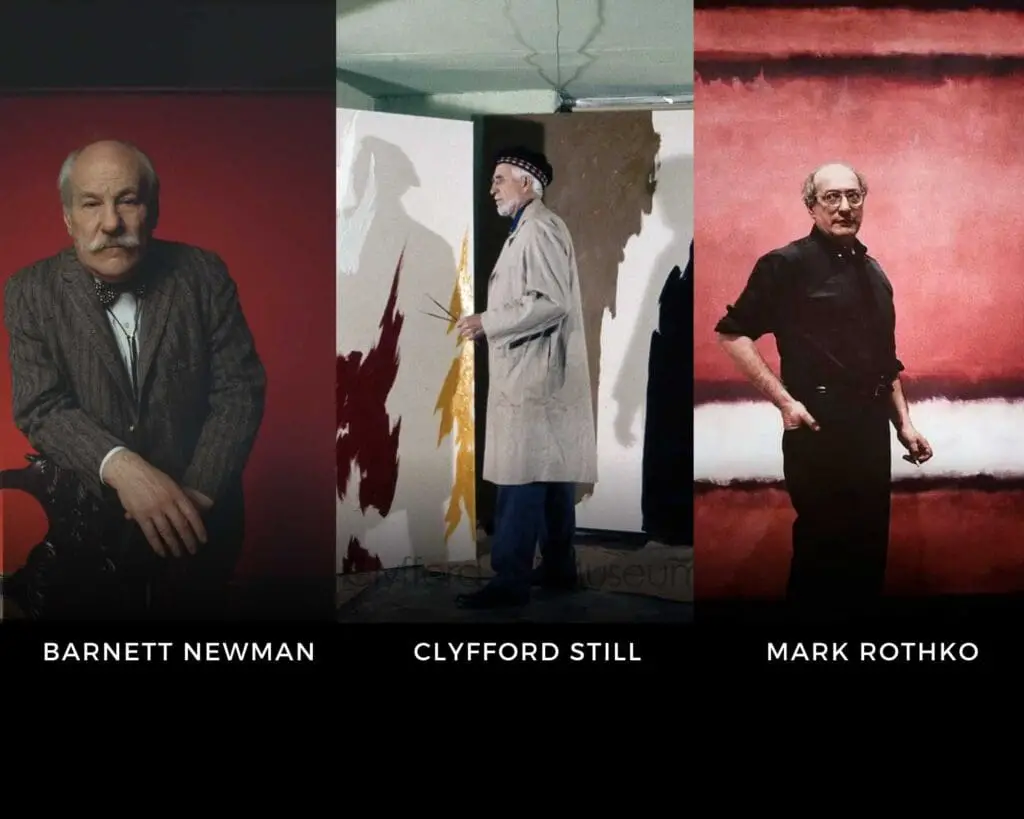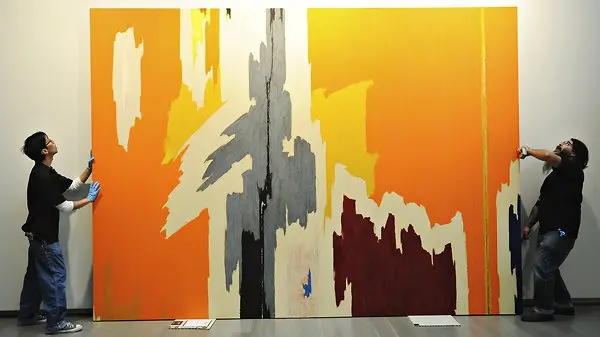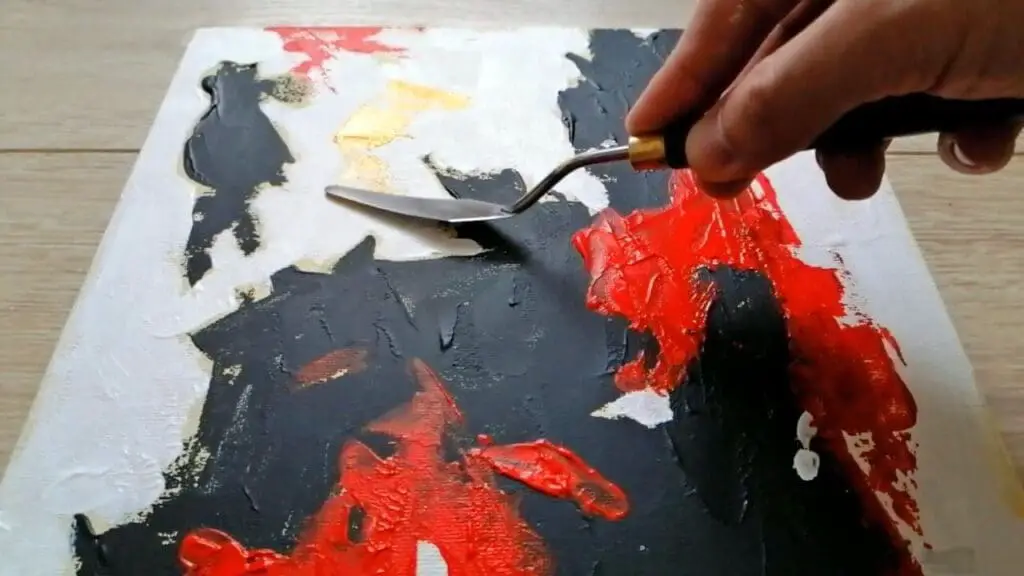Clyfford Still is one of the greatest American Abstract Expressionism Color Field painters. He is considered one of the essential Abstract Expressionism painters to ever lived.
Clyfford Still is an Abstract Expressionism artist who is known as a color field Abstract Expressionism artist. He is best known for his colorful yet jagged-edged paintings that are oversized and thought-provoking. Many of his paintings were never sold, yet he was an extraordinarily prolific and influential Abstract Expressionism painter.
Table of Contents
- Clyfford Still And Abstract Expressionism
- Clyfford Still – Color Field Painting And Abstract Expressionism
- About Clyfford Still – And His Paintings
- Frequently Asked Questions
- Related Questions
Clyfford Still And Abstract Expressionism
Clyfford Still started taking art seriously when he was in high school. He was so good that he was able to win a scholarship to college. He spent the first part of his life teaching at the University level.
When Clyfford Still taught in San Francisco from 1946 to 1950, he started developing his signature art style of Abstract Expressionism.
He is considered one of the greatest Abstract Expressionism artists. However, like many other artists, he did not sell many pieces of his artwork during his lifetime. Clyfford Still kept most of it together in one collection.
That is why the Clyfford Still Museum in Denver is so important, as the museum was given his entire collection of art so that Clyfford Still’s art could be enjoyed in full.

In speaking of his painting process, Clyfford Still said this:
”A great free joy surges through me when I work… with tense slashes and a few thrusts the beautiful white fields receive their color and the work is finished in a few minutes.”
Clyfford Still
Clyfford Still – Color Field Painting And Abstract Expressionism

Clyfford Stills is usually categorized as an Abstract Expressionist artist who started color field painting along with Mark Rothko and Barnett Newman. Color field painting is considered a style of Abstract Expressionism painting.
The color field painters were generally concerned with religion and myths and used color to create a contemplative or meditational response from the viewers. Clyfford Still speaks about how people should interpret his paintings and says this:
“People should look at the work itself and determine its meaning to them. I prefer the innocent reaction of those who might think that they see cloud shapes in my paintings to what [a critic] says that he sees in them.”
Clyfford Still
Clyfford Still’s paintings were unique from other abstract expressionism because he was also known to mix color field painting with action painting. Clyfford Still blended the two forms of Abstract Expressionism, the color field painting and action painting, in his paintings.
That is why many of the other great Abstract Expressionism painters, such as Jackson Pollock, Mark Rothko, and Barnett Newman, were thought to look to Clyfford Still to see what he was doing with his painting and be inspired by it.
About Clyfford Still – And His Paintings
To fully understand Clyfford Still, you need to understand his way of painting or what set him apart from other Abstract Expressionism artists of his time. Here are some of the significant ways:
Clyfford Still’s Imagery
Clyfford Still’s imagery is unique. His artwork does not contain natural forms but instead usually large jagged objects.

Clyfford Still’s way of painting differs significantly from other color field painters, particularly Mark Rothko and Barnett Newman.
Clyfford Still said this about his art:
“I felt it necessary to evolve entirely new concepts — of form and space and painting — and postulate them in an instrument that could continue to shake itself free from dialectical perversions.”
Clyfford Still
Clyfford Still’s Art Is Large Scale
One of the great things about Still’s work is its large and massive size. The painting would often play to the canvas’s very edge.

There is usually not one focal point for the painting, but there are many focal points. In speaking of the large size of his images, Still said:
“It’s intolerable to be stopped by a frame’s edge.”
Clyfford Still
Part of the large-scale canvas was so there was movement on the canvas. When you look at one of Clyfford Still’s paintings, your eye usually goes all over the canvas as there is a lot of movement and a lot going on the canvas.
Clyfford Still’s Painting Technique
Clyfford Still was known to apply his paint with a trowel and palette knife as he would layer his paint on the canvas, making his trademark jagged edges. His paint would sometimes be layered very thick and, other times, significantly thinner.

The way he applied the paint on the canvas gives the canvases a unique, almost three-dimensional feel up close. You can practically feel him applying the paint onto the canvas surface.
The Lifeline And Clyfford Stills

One theme that runs through Clyfford Stills’s work is a small line. He called it a lifeline.
When he was young, his father dug a well on their farm to see if there was water; he dropped the young Clyfford Stills down the well, hanging him by his ankles with a rope.
In many of Clyfford Still’s paintings, you will see small lines that may go up and down or around the canvas – they all refer to this line or what he called the lifeline. Clyfford Still felt that Barnett Newman copied him after seeing some of Still’s work and also started using a line on his canvases.
Many people who look at Still’s paintings may mistake them as simple, but in reality, they are very complex works of art that are layered upon layers. Some areas are thick, and other areas are thin. It is all part of his painting technique and our experience with the canvas.
In speaking of this, Clyfford Still said:
“I do not intend to oversimplify – in fact, I revel in the extra-complex.”
Clyfford Still
Clyfford Still is one of the greatest Abstract Expressionism artists and one of the most influential artists of the 20th Century. He showed us all a way to paint and appreciate art; his art inspires many artists today.
Anita Louise Art is dedicated to art education, great artists, and inspiring others to find and create their art. We love art that uplifts and inspires. #ArtToMakeYouSmile! #ArtToMakeYouHappy!
If you want to see any of my art, you can find out more by clicking here. If you are interested in what inspires me and my paintings, you can discover more by clicking here.
We have a free newsletter and would love you to be part of our community; you can subscribe to the newsletter by clicking here. I would be happy to talk to you if you have any questions. You can reach me, Anita, by clicking here.
Subscribe to our Anita Louise Art YouTube Channel with great videos and information by clicking here.
Join us for our podcast “5 Minutes With Art.” Spend just 5 minutes a week with us to discover and learn about great art and artists. You can find out more about our podcast by clicking here.
Frequently Asked Questions
Who is Clyfford Still, and what is his significance in Abstract Expressionism?
Clyfford Still was a prominent American Abstract Expressionist painter, known for his contributions to the movement. He is considered essential in the history of Abstract Expressionism for his unique approach to color field painting and powerful, large-scale canvases.
What is Color Field Painting, and how does Clyfford Still contribute to this style?
Color Field Painting is a style within Abstract Expressionism that focuses on large expanses of color with minimalistic or no distinguishable brushstrokes. Clyfford Still is a key figure in this movement, using vibrant colors and jagged edges to create visually intense and emotionally charged compositions.
Why are Clyfford Still’s paintings often described as oversized and thought-provoking?
Still’s works are often large in scale, creating an immersive experience for the viewer. The combination of bold colors and jagged forms in his paintings prompts contemplation and emotional engagement, leading to a thought-provoking experience.
Why were many of Clyfford Still’s paintings never sold during his lifetime?
Clyfford Still was known for his uncompromising attitude towards his art. He wanted complete control over his work, including how it was exhibited and sold. As a result, many of his paintings remained in his possession, making them rare and highly sought after after his death.
How did Clyfford Still’s prolific and influential career impact Abstract Expressionism?
Still’s prolific output and influential style helped shape the trajectory of Abstract Expressionism. His bold use of color and innovative approach to composition influenced subsequent generations of artists, leaving a lasting mark on the movement.
What distinguishes Clyfford Still’s color field paintings from other Abstract Expressionist works?
Still’s color field paintings are characterized by their monumental size, intense colors, and jagged, irregular shapes. Unlike some other Abstract Expressionists, Still’s compositions often lack identifiable figures or recognizable forms, emphasizing the emotional impact of color and form.
How did Clyfford Still’s personal life influence his art?
Still’s tumultuous personal life, including struggles with institutions and the art market, played a role in shaping his artistic philosophy. His desire for independence and control over his work reflected his commitment to the authenticity of his artistic expression.
What is the legacy of Clyfford Still in the art world?
Clyfford Still’s legacy lies in his significant contribution to Abstract Expressionism, particularly Color Field Painting. The Clyfford Still Museum, dedicated solely to his work, stands as a testament to his impact on the art world, preserving and showcasing his vast body of work.
How did Clyfford Still’s work evolve over his career?
Still’s early works featured more representational elements, gradually transitioning to fully abstract compositions. His later paintings, often monumental in scale, embraced a more intense use of color and jagged forms, marking a distinctive phase in his career.
What role did Clyfford Still play in the broader context of Abstract Expressionism?c
Clyfford Still was a key figure in the development of Abstract Expressionism. His commitment to emotional expression, rejection of conventional norms, and exploration of color field painting contributed to the movement’s diversity and lasting influence on the art world.
Related Questions
Why Was Impressionism Art at First Rejected?
During the era of impressionism art, fine art oil painting was an extremely important addition to the interior design of a home, especially for the affluent and the increasing arrival of the middle classes. For these art patrons, there were only some very specific styles of art that they considered acceptable for them to use for the interior design of their home and impressionism art did not fit into any of these culturally acceptable fine art categories.
To find out more about this, you can read our blog on Why Was Impressionism Art at First Rejected? by clicking here.
Who Were Some of the Women Impressionist Artists?
When we think of Impressionist art, most people think of all the famous male artists. But many women were considered significant women impressionist artists. The seven significant women of impressionist painters are Berthe Morisot, Mary Stevenson Cassatt, Marie Bracquemond, Louise Catherine Breslau, Eva Gonzales, and Lilla Cabot Perry. Each of these women in their own unique ways, contributed to the impressionism art movement.
To find out more, you can read our blog on 7 Women Impressionist Artists, To Admire, Know and Remember by clicking here.
All About En Plein Air Painting, What You Need to Know
En Plein air means “in the open air. It refers to a style of painting outside in the natural light. This term was made famous by the French Impressionist art movement. Many of the French Impressionists painted most of their paintings outdoors. There was a lot of equipment and other challenges associated with painting everything outdoors.
You can learn more by reading All About En Plein Air Painting, What You Need to Know by clicking here.

